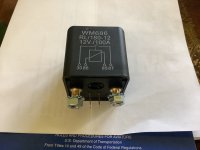WaterH
Well-known member
So yesterday I installed a relay before the starter and it starts every time. I also installed a second 75 amp relay on the AC fans. (One for each fan) and it appears to work fine. The 75 amp is overkill for one fan but I had them As aposed to buying two smaller relays or one higher relay. We’ll see how it works.
In other news, the wiper motor is working fine now. The problem with them not parking maybe because they go to fast when the window is wet. I know they won’t park if I remove the arms. The drag of the arms makes them go slow enough to allow the park system engage. Not really sure how to fix this. I guess I could just let them run till they dry enough and shut off.
I also ordered some new thermostats for my rad fans. But I still think I will wire one to a dash switch. This kind of sucks because I only have extra switches available in my upper console. I would prefer this switch in the lower one. So I may have to move something else up.
In other news, the wiper motor is working fine now. The problem with them not parking maybe because they go to fast when the window is wet. I know they won’t park if I remove the arms. The drag of the arms makes them go slow enough to allow the park system engage. Not really sure how to fix this. I guess I could just let them run till they dry enough and shut off.
I also ordered some new thermostats for my rad fans. But I still think I will wire one to a dash switch. This kind of sucks because I only have extra switches available in my upper console. I would prefer this switch in the lower one. So I may have to move something else up.

